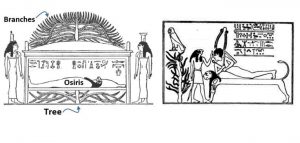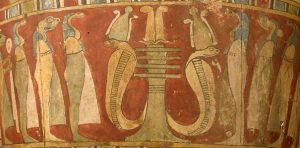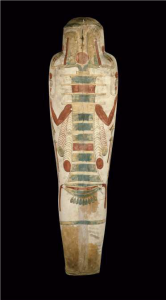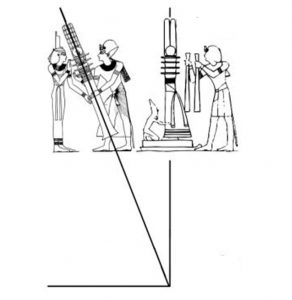Wadi Al-Hitan
Valley of the Whales
by Suzan Moore
The world is full of wonderful and mysterious things, many of which are hard to explain.
One of the big wonders is: how do we get whales in the middle of the Egyptian desert? From a geological standpoint it is very easy to explain, so let’s consider the geology of northern Egypt during the Eocene Epoch.
Wadi Al-Hitan or “Valley of the Whales” is 150km southwest of Cairo and west of the El-Fayum area. This area is a desert now, but it looked vastly different many years ago.
Back in the late Eocene Epoch, roughly 40 million years ago, this part of Egypt was covered by the Tethys Sea. At various geological times in the last 150 million years, the seaway extended south of the present-day city of Aswan. The seaway fluctuated due to interaction between the European tectonic plate edge and the African tectonic plate edge, which now run through the present-day Mediterranean Sea. They were constantly in a push-pull relationship that caused the rise and fall of the Tethys Sea, as well as resulting in mountain formation throughout the area. Around 30-40 million years ago, towards the end of the Eocene, the rising of the Arabian Plate caused the Tethys sea to migrate northward, drying up to the present-day Mediterranean shoreline. There was once abundant sea life in the area of Wadi Al-Hitan; In addition to 2 types of whales, there were also sharks, crocodiles, sawfish, turtles, rays, and plentiful shells mainly in the form of Numalites. Ancestral elephants and some of the earliest known hominoids were found there as well.

Tethys Sea, North Africa, Cretaceous Time
The Valley of the Whales is roughly 20km long and is thought to have been a shallow bay within the Tethys Sea with an ample food supply and protection from predators. It is believed that Wadi Al-Hitan was a preferred area for the whales to give birth to their young.

Tectonic Plate edges
The whales found here were semi aquatic and thought to be a transition between foot and tail powered swimmers. Initially they were mistaken for reptiles or dinosaurs and named Basilosaurus, meaning “King Lizard”. They were later determined to be early whales while the smaller ones, once thought to be juveniles, were identified as a second genus of whale now named Dorudontines.
Geologically, the area is complex with the lower portions being a marine limestone. Above this is a mixture of open marine and lagoonal sequences with deltaic sandstones and mudstones also found. As the area dried up it left suitable environmental conditions for the amazing preservation of the whales and other specimens.

Shallow bay between Eocene land masses (shown in brown)
Now this area is very arid and dry. It is a desert full of sand dunes, cliffs, ridges, and valleys that are difficult to access, but the stark beauty of the area makes it a very interesting place to visit.
The Djed Pillar:
The Most Enigmatic Symbol of Ancient Egypt
by Mohamed A. Fahmy
Since pre-dynastic Egypt, the Djed pillar appeared as an important symbol and has remained so throughout Egyptian history. As one of the most complicated symbols yet to be found, it has taken different shapes and forms which has only increased the difficulty to understand its nature and purpose.
Although it was widely used as a religious icon throughout much of the history and geography of Ancient Egypt, it is still not clearly understood what the Djed was originally conceived to represent. Determining its meaning from its appearance alone is no easy task.
The Djed is the oldest symbol of Osiris, and symbolizes his backbone and his body in general, the Djed hieroglyph is a conventional representation of a part of his spinal column and is said to mean: ‘to be stable, to be permanent, abiding, established firmly, and enduring’.
The reconstruction of the body of Osiris occurred at a place called Djedu and it was here that the yearly ceremony of ‘Raising the Djed Pillar’ took place on the last day of the month of Khoiak, the eve of the agricultural New Year. The next day marked the beginning of the four-month long season of Pert, during which the lands rose out of the flood waters allowing the fields to be sown. Djedu was also referred to as Per-Osir-Neb-Djedu, meaning ‘The House of Osiris – the Lord of Djedu’. The Greeks called it Busiris, after the shortened title Per-Osir as ‘The House of Osiris’.
Mythologically, the ‘Raising of the Djed’ symbolized the resurrection of Osiris, and with its annual re-enactment represented the death and renewal of the yearly cycle. Osiris is referred to as ‘Lord of the Year’ in the Pyramid Texts, and as the god of agriculture, his annual resurrection ensured the stability of the abundance of the next season’s crops.
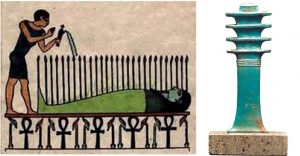
The general concept of the Djed symbol appears to be a combination of the backbone of Osiris, a column or pillar, and the trunk of a tree. The legend of Osiris as told by Plutarch reinforces this interpretation. The story involves the murder of Osiris in which his body is trapped inside a chest and becomes enclosed in a huge tree at Byblos. The trunk of this tree containing the body of Osiris is then cut down and turned into a pillar for the house of the King. This pillar is referred to by the Djed hieroglyph and the branches of this magnificent tree were said to have been turned to the four cardinal points.
All over the ancient world, the reaping of the harvest was imagined as killing and dismemberment of a spirit whose vital essence was kept in the last sheaf, and the harvest ended with rites, which reasserted the life of the spirit. With raising the Djed-pillar, the essence of life returns to earth again, as for the humans that inhabit it. The erection of the spin and the supernatural power of the Djed-pillar will help the deceased to ascend and return to the universe as celestial entities.
The Djed has been said to be the support of the sky and the pillar of cosmic stability. Sometimes he is replaced by Shu in his role of the supporter of heaven and at times referred to as the ‘raiser up of heaven upon its four pillars’ as the Djed with arms upheld supporting the sky. In a hymn inscribed on the walls of the temple of Esna, the Djed is called ‘the prop of heaven who has spread out the same with his hands’.
The Djed pillar was among the amulets meant to magically protect or assist the Ancient Egyptians in life and death, directly associated with the underworld deity Osiris. This amulet is usually shown with eyes, arms and various attributes of the god.
Although the Djed may have had a different origins, it was generally regarded as a representation of Osiris’s backbone, and amulets were made in this form could also signify the concept of support and stability and as such, the Djed appears not only as an amulet used on the mummy of the deceased but also painted along the inside of the coffins and depicted on pillars and other architectural features.
Chapter 155 of the Pyramid Texts describes the power of the golden Djed to protect and ascend the spirit of its bearer.
“Raise yourself Osiris, to place yourself on your side, so that I may place water of eternity under you.
I have brought you a Djed-pillar of gold so that you may rejoice by it.
Words spoken over a Djed-pillar of gold strung on a fiber of sycamore
and placed at the neck of the blessed dead on the day of burial. Anyone at whose neck this amulet is placed, will be an eternal spirit who is in the necropolis on the day of the First of the Year like those who are in the following of Osiris
A correct matter a million times.”
This Chapter was a mighty spell that enabled the deceased to rise up, and, because he was provided with his backbone and his neck vertebrae, to stand in his place on his feet; in other words, it effected his resurrection. In the miracle plays that were performed annually at Abydos and other towns in Egypt, the ‘raising the Djed-pillar’ and placing the head of Osiris upon it was the most important scene, and it indicated that the body of the god had been reconstituted, and that he had risen from the dead.
It is interesting to note that the Djed referred to in the Chapter is made of gold. This metal was believed to possess great and peculiar properties because the blood of the Sun-god was made of gold.
When the Egyptians celebrated the ceremony of raising the Djed-pillar as depicted in many sacred sites and especially at the temple of Seti I at Abydos, it was not just a celebration of harvest but beyond that, besides it’s funerary symbolism and ascended the spirit of the pharaohs, the gold properties and the angel of the Djed itself has brought many hidden meaning and theories about the nature of the pillar.
In her discussion of the nature and propose of the Djed-pillar, Rosalind Park suggested that while the proficiency of the ancient Egyptians in geometry has never been in dispute, connections of astronomy and geometry to religion and the human body come to mind with the linkages of the cardinal points: sky deities, and internal body organs. The calendar and the system of decans argue for a certain level of sophistication and observational expertise, especially with regard to knowledge of the precession of the equinoxes. Calendar design comes from the simultaneous observations of the Sun and the stars, particularly in relation to their heliacal rising and setting. From this would logically follow the recognition of the zodiacal or ecliptic constellations. This method requires no prior knowledge of the Poles, meridian or celestial equator. However, an alternative method does concern the Pole star and the circumpolar stars which never rise or set. It is associated with the concept of the meridian, derived from the use of the gnomon for the systematic determination of the culminations and lower transits of the circumpolar stars. These were called by the ancient Egyptians Ikhemu sky (literally ‘those who do not die’) generally translated as the ‘Imperishable Stars’.
In the perceived distance, a figure of a White Crowned king kneels on a plinth and touches the side of the Djed column. This hitherto unnoticed Egyptian geometry anthropomorphizes what the Greeks would have recognized as a Parallel of Latitude diagram in their version of the same thing, namely picturesquely showing the angles formed by the intersection of the terrestrial equator and North-South axis with the horizon.
The Djed-pillar was used to observe the stars now called decans and was used by the priests to determine the axis of earth until later it was used to measure the diameter of earth, more on that in next article.
To be continued ……
Mohamed A Fahmy: Egyptologist & Tour Guide:
Born in Aswan, Egypt, Mohamed Fahmy graduated with honors from Minia University with a double degree in Egyptology and Tourism, He joined various archaeological expeditions in Saqqara, Luxor and Aswan, as a volunteer, for 12 years. Mohamed continues his study of Egyptology in the fields of ancient Egyptian history, language, literature, religion, architecture and art from the 10th millennium BC until 4th century AD, with a focus on the symbolism and philosophy of the Egyptian language as an element of eternity and resurrection. Gaining his Masters degree on the symbolism of art in the new kingdom temples and tombs in Luxor, Dendera and Abydos, he is now working toward obtaining his Doctorate.



